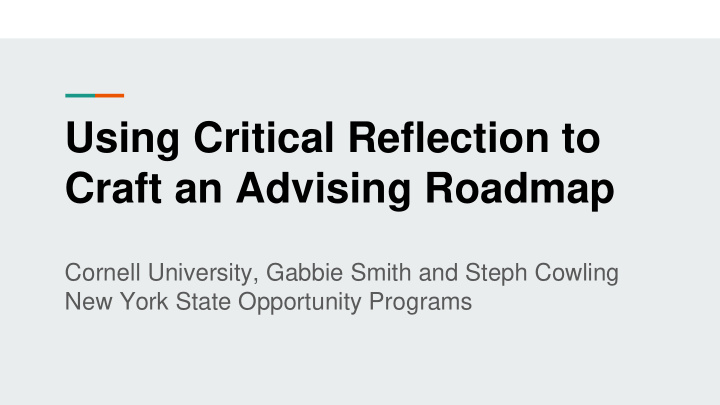



Using Critical Reflection to Craft an Advising Roadmap Cornell University, Gabbie Smith and Steph Cowling New York State Opportunity Programs
New York State Opportunity Program Profile I n our EOP/HEOP office we serve … ● 204 students across all 7 colleges in Cornell who are low income and predominantly first generation ● Student Cumulative GPA: 3.1 GPA ● Graduation Rate: 95% (6 year rate) ● Our program staff of 6 ○ 4 advisors ○ 1 assistant director ○ 1 director
Have you ever? ● identified recurring areas where your students need the most support ● had a conversation with a colleague about how best to support your students ● wondered if you are utilizing your advising sessions and advising sequence in the most strategic way ● considered if your program design and structures maximize opportunities to support students
Our Project and Rationale Project : Craft an Advising Roadmap (or Learning Plan) Rationale : ● Formalize our informal thoughts and conversations ● Build a shared understanding of and articulate our students experiences, their needs and how best to support them ● Determine how to maximize the support we provide to students
Workshop Objectives Engage in a process of critical reflection with colleagues in order to: ● reflect on our beliefs about students and areas where they need support ● identify the strengths of and gaps in our programs ● consider how to tailor this process to meet the needs of your team and student population
Today’s Agenda 1. Discuss our beliefs about our students 2. Identify where our students need support 3. Share example of learning plan 4. Debrief our process
What We Believe About Our Students Individual Activity: Take a moment quietly to consider what you believe about your students. Specifically, what are their strengths (their qualities and talents) and what’s important to them. As a group, chart these beliefs. Group Discussion: ● What do you notice/wonder about the beliefs listed? ● What is the value in reflecting on our beliefs about our students?
In What Ways Do Students Need Our Support? Individual Brainstorm: ● Identify 3-5 areas where we see students struggle, need support or have room to develop. ● Write each idea on separate post-it notes.
In What Ways Do Students Need Our Support? Categorizing Your Ideas: ● Share your post-its with your group ● Notice categories you see emerging ● Groups post-its into categories on chart paper ● Write a title for each category
What Students Bring and Where They Can Grow ● What do you notice? ● How might you use the ideas generated from this exercise to inform next steps about your advising program design? ● How might these ideas inform your advising?
Creation of the Learning Plan Planning Steps Our 6 Categories ● Currently, we are flushing out by category 1. Financial the goals and touchpoints for each student year 2. Personal Wellness ● Crafting our advising curriculum based on 3. Professional the learning plan 4. Academic ● Building in structure during team meetings 5. Social/Community to discuss progress 6. Civic Engagement & ● Evaluating: Are we leveraging our Responsibility programming to align with these goals?
Group Debrief ● How might you use or adapt this process? ● What successes/challenges do you anticipate?
Thank You and Evaluations Gabbie Smith: gcs24@cornell.edu Steph Cowling: ssc266@cornell.edu
Recommend
More recommend